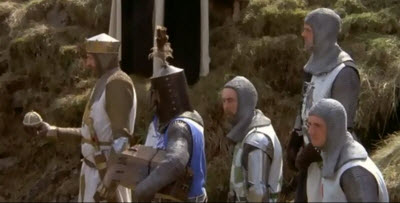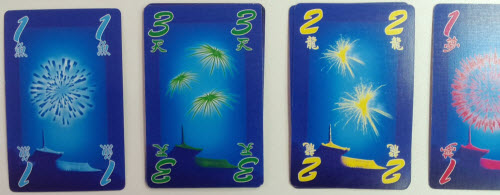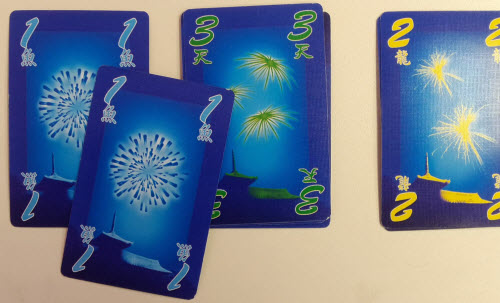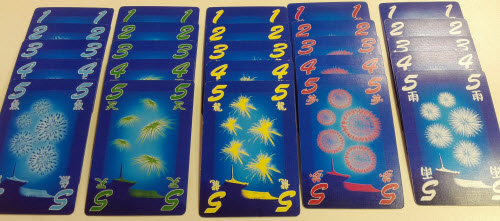“If you’re so sure you mixed them properly, why do we have all this extra powder?” – Hiroko Ishida, last words
The Premise
Hanabi drops players into the role of forgetful fireworks makers who have botched up the fireworks for an impending show. Players must work with one another to recompile as much of the fireworks as they can into the correct sequences to provide the best show possible.
The Rules

“One…Two…Five!”
With the exception of some tokens, Hanabi is purely a compact Co-Op card game that’s capable of being played right out of the box. The cards in the deck range in number from one to five and come in five different colors, and the objective is to arrange them into stacks of 1-5 in each color.
To begin, each player receives four or five cards, depending on the number of players. The catch with Hanabi, however, is that players are not allowed to look at their own cards. Instead, everyone plays such that their hands are facing the players. Therefore, each player knows what everyone has for cards – except for their own.
In Hanabi, the player with the most colorful clothing starts, as this is a game about bright and colorful fireworks. (How a group interprets colorful clothing is up to them.)
On each player’s turn, they take one of three possible actions: Give Information, Play a Card, or Discard a Card.
When a player chooses to Give Information, they provide another player with a hint about the contents of their hand. This is done by using Clock tokens. There are eight of them in Hanabi, and this action can only be taken if there is a Clock token available. The player removes a Clock token from the pile and chooses a player. That player is given one piece of information about either the color(s) or number(s) of their cards, such as “These cards are Blue”, or, “These two cards are twos”. Information must be complete, pointing out all applicable cards of whatever statement is made, and the person receiving the hint is free to rearrange or move their cards around to help remember this new information however they wish.
If a player chooses to Play a Card, they select a card from their hand and, well, plays it. Players are attempting to arrange each of the five fireworks stacks sequentially. If the card can be placed on a stack, it is done so. If the card cannot, it is discarded, and a Fuse token is removed from the pile. (For instance, if someone plays a Green 3, the top card of the Green firework pile must be a 2 to be successful.)

Normal firework stacks. Off to a good start!
Lastly, a player may opt to Discard a Card. To do so, a player recovers a spent Clock token and discards a card of their choosing. Whenever a card is removed from a player’s hand, either as a result of playing or discarding it, another card is drawn without looking and added to their hand.
Players continue to take turns until one of the three conditions are met:
- The players assemble all 25 fireworks cards correctly.
- Players use three Fuse tokens.
- The draw deck is empty.
If players succeeded at placing 25 cards, they are deemed to have won the game in earnest, whereas if players only manage 5 or less cards, they are deemed total failures. Much dishonor will ensue. Otherwise, players consult the chart in the rules to see their relative score.
Still, it’s likely anything less than 25 will still bring shame to your families.
Trust Exercises
Playing Hanabi is akin to attempting a multiplayer Sudoku puzzle. Each player is shown a different portion of the information, and it’s up to the group to come up with the best course of action each turn. With a limited number of clues to hand out and a very small margin for error, making the correct decision is pivotal to success. Moreover, like other puzzle games, the level of its appeal and/or frustration isn’t determined by its handful of rules. Rather, one’s enjoyment of the game will largely be based on their interaction with the other players.
Firstly, there is the group dynamic factor. How well you’ll fare at Hanabi is determined far more by the people you’re playing with than by figuring out the logic puzzle of what hints to give or cards to play. While Hanabi is simple enough to be played as a pickup game or small party game, your chances of getting a high score are far more likely with people you’re familiar with – or if you happen to be good at reading other people. Since you’re unable to see your own cards, you must trust in other players to guide you towards making the optimal move on your turn.

Miscommunication leads to the wrong cards played, which leads to explosions.
(And not the good kind.)
It’s important to understand, then, that how you say something, via your tone and diction, is just as important as what you’re saying. Humans generally pick up on these cues instinctively, such as being able to tell when a person is conveying different emotions even if the exact same words are used.
However, unless you’re taught to hone in on these cues, reading a stranger is more difficult than your family members or friends. Hanabi’s greatest strength – and it’s greatest weakness – is that the enjoyment level of the game will be determined by how well the group functions to solve their task.
Don’t just presume another player is going to interpret your hints of what they should do next the exact same way you would. If a player is incorrectly inferring the clues you’re providing them, your odds of winning drop significantly.
Secondly, because victory or defeat hinges on the group working coherently, it can sometimes be tense as the best course of action is plotted. And that can lead to a despot player. As with many co-op games, there are occasional openings for certain personalities to “take over” as de-facto leaders, dictating what each player should to to ensure victory. (Tacticians are the most susceptible Archetype to this.) Since Hanabi is designed to be simple and lightweight, it doesn’t have a lot of in-game ways to mitigate this factor. To avoid unpleasant situations, then, we highly encourage continual and open discussion when playing as a means of dampening the instincts of those with more “alpha” tendencies. Hanabi already has enough fireworks present.

This is what you’re all aiming for. So pretty…
Keeping Them Guessing
Hanabi is a game that does not want to be categorized easily. It is not a card game in the normal sense, whereby each person’s hand of cards provides a fixed set of options. It is not a party game, as it’s designed for 2-5 players and requires both focus and memory retention to successfully win. It’s closest by definition to an abstract game, but since most abstract games don’t rely on hidden information and card randomness as a factor in winning (as Hanabi does), it doesn’t fit perfectly there either.
Unsurprisingly, then, the nature of Hanabi doesn’t appeal to everyone. Even though most games only take about a half hour, this card game requires heavily player involvement, a fair amount of concentration, and a bit of luck to succeed. There is little in the way of interesting components for Architects, Daredevils, or Immersionists. There is little in the way of growth or expansion, and the theme is as rudimentary as the card drawings themselves. There’s far too little room for mistakes.
Strikers too may have issues with Hanabi. It’s a challenging game with a decisive goalpost, and that may enough for some to overcome their natural aversion to co-op games. On the other hand, the relative degrees of victory and the game’s heavy reliance on other players to chart their next move may put them off just as easily.
As strange of bedfellows as they are, Hanabi is ideal for both Socializers and Tacticians. The game is extremely portable, can be taught in under a minute, is incredibly rules-lite, and every player is involved in the game no matter whose turn it is. It’s great for those who like the feel of party games but want some substance to them.
Similarly, Tacticians will like the surprising complications that arise from something as simple as not knowing your own cards. The game often is played on a razor’s edge between victory and defeat, and it’s essential to knowing ahead of time what your next move should be. That they can get a game requiring forethought and planning into a half hour session will certainly be appealing to this group if they have time or space constraints.

Looks like we’re almost out of time…
The Takeaway
The fact that Hanabi isn’t easily quantifiable doesn’t mean the game isn’t interesting and rewarding; it did win the Spiel des Jahres after all. Hanabi’s gameplay is remarkably simple, but actually getting all 25 cards aligned correctly is a very difficult task. Still, getting to 25 is not intended to be easy, or common, and this challenging peak gives the game a good deal of replayability. Its major hook – that you can’t see your own cards and are reliant upon other players – is surprisingly effective for making the game notable. It takes the idea of playing with limited information and turns it inside out, creating a wholly unique game of deduction. The result is a fun little card game that requires little effort to set up but more than a modicum of effort to succeed at. It’s decent for family and party settings, or as a nice wind-down game after something more taxing. Granted, it isn’t for everyone, but for those who appreciate the uniquely strategic-but-social attributes it offers, it should be an explosively good time.
Hanabi is a product of R&R Games.
Cardboard Republic Snapshot Scoring (Based on scale of 5):
Artwork: 2
Rules Clarity: 4.5
Replay Value: 4.5
Physical Quality: 3
Overall Score: 4
Photo Credits: Monty Python by Sony Pictures.
